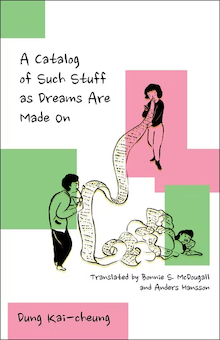
translated by Bonnie S. McDougall and Anders Hansson
Columbia University Press, 2022
Reading Dung Kai-cheung’s A Catalog of Such Stuff as Dreams Are Made On is like descending into a beautiful fever dream of Hong Kong in the late ‘90s. The story collection is both a time capsule, capturing Hong Kong through pop culture references like Hello Kitty and Air Jordans, and an incantation, breathing life into a surreal cast of characters who transform themselves, literally and metaphorically, through their pop culture choices.
The title of each flash vignette refers to a pop culture element that plays a central role in the story. Some of these allusions are recognizable — Snoopy, Teletubbies, Windows 98. Others refer to more general items like combat trousers, colored sunglasses, and bucket hats. Still others are particular to Japanese culture, such as Puffy (a pop group), the fashion magazine non-no, and Konjak jellies. The translators have included brief notes at the beginning of each story which helpfully identify its various pop culture references. But even without these notes, most of the allusions are easy to glean from context.
Rather than hiding pop culture references throughout the text like a Where’s Waldo of ‘90s consumer trends, Dung allows these items to comment on the identities we fashion for ourselves and those that are thrust upon us. In ”Agnès b,” the brand is one character’s central identifier: “The first time Ka Tsai took the train to his office, he saw a young woman with an Agnès b. bag hanging from her left shoulder, standing on the platform with her back toward him.” Rather than being an extraneous detail, the bag becomes a vehicle for commentary on everything the narrator can see and imagine about this woman — her age, social class, and physical attributes, including her curved spine. Curves echo throughout the story, from the protagonist’s twisted neck from a minor car accident to “the whole stretch of the railway line in front of [Agnes b.] curved to the left,” all of which foreshadows the curveball at the story’s end.
Every story in this collection is laced with such subtle subversions of expectations. Often these surprises include moments of quiet surrealism in which the titular item plays a central role. As soon as Flower slips on a Seiko LK watch, time passes slowly. Chiu Yi Lan becomes incredibly itchy after wearing anything brand new, so she can only wear secondhand clothing. Siu Pei becomes increasingly mercurial when she adopts a Cutie Punk style. Hoi Ka begins losing weight when she eats Konjak jellies. Many of the protagonists are young women, and their attitudes toward pop culture express the exuberance and naivete common to young people searching for a sense of self. Often, each character’s transformation has the same shelf life as the limited-edition Snoopy figurines in the McDonalds Happy Meals sold in Hong Kong in 1998.
While some young women exercise some autonomy in their transformations, like Sui Pei adopting a Cutie Punk style or Ho Chi deciding to collect Snoopy dolls even though she “was not in fact very particularly fond of Snoopy,” many protagonists have transformation thrust upon them. The author maintains a sympathetic focus on these young women (and occasionally young men) who are forced to deal with other people’s expectations. In one poignant example, Stanley Lau works at a mobile phone store and becomes obsessed with a young woman known only as Stargirl (because of her StarTAC mobile phone). After Stanley programs Stargirl’s number into his phone, he follows her to a park and gives her a call. It turns out that she was waiting for someone else to call, the only other person to have her phone number, and after the unsolicited call from Stanley, she bursts into tears, tosses her StarTAC phone into the river, and disappears.
The stories’ endings range from humorous to melancholy to poignant. This range keeps the stories from becoming stale and repetitive, allowing the reader to appreciate each perfectly formed morsel. The simple, airy prose style and brevity of each story allow the author to inject elements of darkness — negligent parents, a sister’s attempt to seduce her estranged brother, a young girl’s suicide. But these dark moments are few and far between, and they add depth to the stories rather than creating an abrupt tonal shift. In fact, all the stories, as simple as they appear to be, benefit from a second reading to tease out patterns of imagery or clever wordplay.
In his preface to the English translation, Dung Kai-cheung draws a parallel between his stories and the now-ubiquitous COVID masks. He notes that the mask has a dual function: It prevents infection while also working as a fashion statement. But just as these masks will, with any luck, eventually become obsolete, so too have the references in the book, written during the beginning of the “one country, two systems” period of Hong Kong’s return to China. In creating “an aesthetic of obsolescence,” the author wraps nostalgia and obsolesce into an aesthetic bow in an “attempt to save things from oblivion.” As he points out, the present becomes obsolete only “when it leaves the impermanent ebb and flow of current affairs and enters the realm of history.” At that point, the COVID mask will be “no longer a symbol of fear but a revelation of truth.” In this collection, Dung Kai-cheung has effected the same transformation by creating a time capsule that’s also a literary achievement.
+++
+
+
+